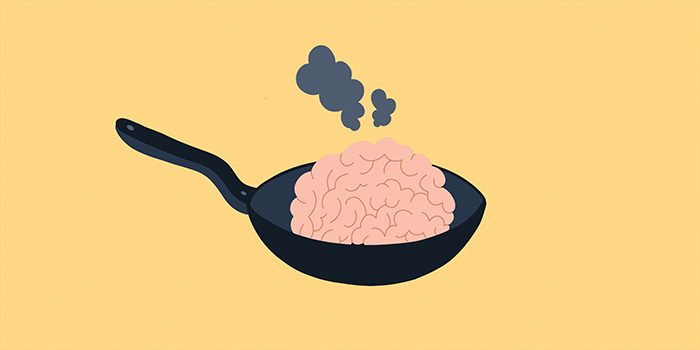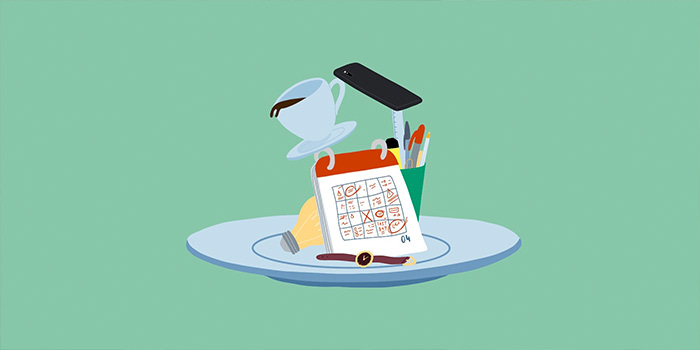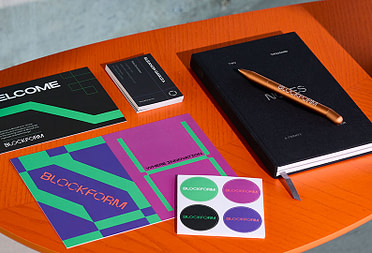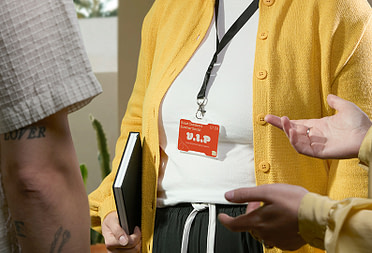Creative burnout. Time to take a break?
Recognize the signs of burnout and overcome creative exhaustion with tips from our community.
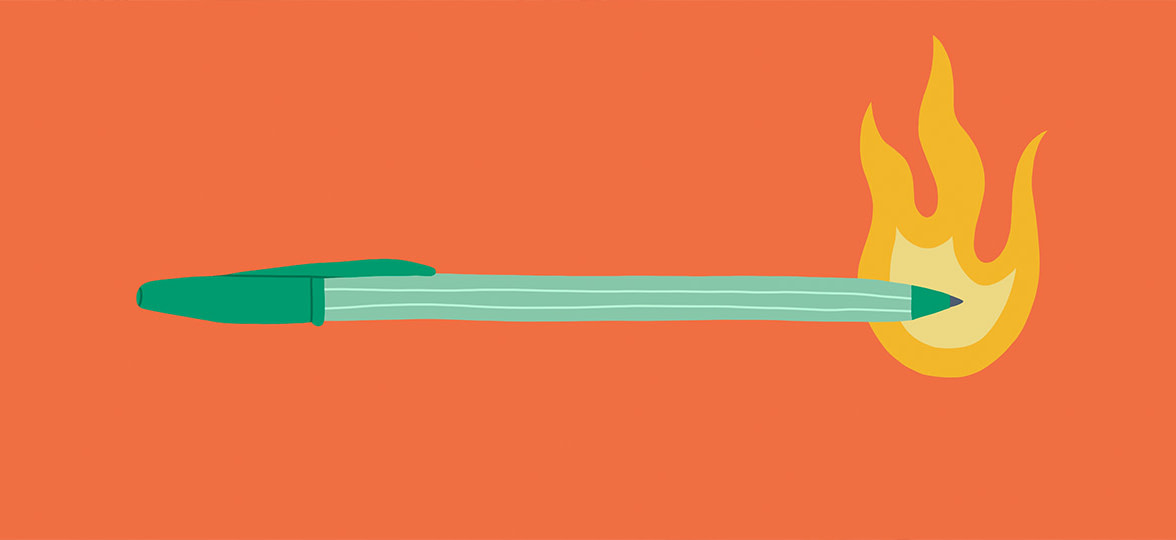
Feeling overwhelmed? Drained? Not sure any good idea’s ever going to come out of your brain again? You’re not alone. According to a 2020 survey,* 75% of workers say they’ve experienced burnout. Blurring the frontier between work and personal life, WFH and burnout are unfortunately compatible – and freelance creatives are not immune.
Recognize the symptoms of burnout and overcome creative exhaustion with our guide to dealing with burnout. Featuring expert tips from Abby Leighton, Cimone Key and Charlie Gould.
Burnout 101
Burnout is not a new concept. Coined in 1974 by American psychologist Herbert Freudenberger, it refers to a psychological reaction to excessive stress over a prolonged period of time, which affects both physical and mental health through symptoms such as exhaustion.
Eager to begin her career without a break, Cimone Key, the founder of CK Creative Studio, experienced her first burnout as a graduate. “These burnouts had never happened to me until I graduated. A quick Google search led me down a path to realize it was indeed burnout. Once I started to feel like I didn’t want to design anymore, I knew something was going on.”
What is creative burnout?
It’s still burnout, but more specific to people working in creative professions. Creative burnout is the feeling that you’ve drained all of your creativity, and there is nothing left. If you’re dreading to start work, feel tired and stressed all the time and suspect you’ll never be able to create something good ever again, you might be experiencing a creative burnout.
Illustrator and lecturer Charlie Gould took a hiatus from illustration for almost half a year as a result of a burnout. “I think it was a combination of overworking, self-induced pressure and feeling ‘stuck’ where I was, both creatively and within my career. The combination of those three factors created a perfect storm that left me completely burned out.”
Too much on your plate
What causes burnouts? We’ll tell you what. Too much work, an unhealthy work-life balance, unachievable expectations from your manager, unclear briefs, frustrating back-and-forths with clients and monotonous tasks… All of this can be responsible for the state of physical, mental and emotional stress known as burnout. If you want to understand what causes it, look at your plate – if there’s too much, not enough or something you don’t like on it, you might be in for a ride on the burnout train.
Utah-based illustrator and designer Abby Leighton knows it too well. “I have experienced burnout many times! I think it’s a normal part of being a professional creative. As with any field, spending every day coming up with ideas can be a lot of work. On top of working at a design firm, I’m running my own online shop and small freelance business. Dealing with all that takes a delicate balance. Something that triggers burnout for me is when I spend a bit too much time on work, and not enough time taking care of myself and giving myself a chance to rest and recover. It’s easy to put too much on your plate, and that’s when the burnout sets in.”
Are you burned out?
As a creative, you might actually have already experienced burnout without realizing it. Forget the stock image of a tie-wearing, middle-aged man holding his head with his hands in the middle of a busy office. First, WFH and burnout ARE compatible – just because you work from your home, doesn’t mean you can’t overwork yourself. Second, burnout symptoms are varied, and it can affect all demographics and professions. Look out for the following symptoms – they can be signs of burnout:
- Exhaustion, feeling constantly drained
- Feeling overwhelmed, unable to cope
- Frustration and feelings of reduced professional ability
- Cynicism and irritability
- Procrastination and dreading to start work
- Frequent headaches, stomach and bowel problems
Burnout takes many forms
Because its causes can vary, burnout doesn’t look the same for everyone. For Cimone Key, the telltale symptoms are both mental and physical. “I get a headache every time I look at my computer and my thoughts get clouded. My body begins to feel exhaustion and stress settling in. At this point, my mind is simply blocked and I’m unable to create virtually anything regardless of the amount of inspiration I try to consume.”
Lack of motivation is a key sign for Abby Leighton. “I can definitely feel the burnout coming on. You start to feel less motivated to get tasks done, things start to feel overwhelming. In general, you just feel tired and start to lack the enthusiasm you usually have.” As for Charlie Gould, burnouts are all about self-doubt. “I begin to just hate everything about the work I produce […]. Nothing is ever quite right. The colors are off, the illustration doesn’t have depth, it’s flat or boring. Then on top of that, imposter syndrome kicks in. Because I think the work is terrible, why should I be working as an illustrator? Eventually I get into a loop of making work constantly because I feel I need just one amazing piece to bring me out of it, but all I do is get caught in a loop and burn myself out. It’s fun.”
Prevention is better than cure
What’s the best way to avoid a burnout? Prevention. Your brain is not a fruit you can press until you extract the last drop of creative juice. Your mind needs rest. It needs care and support. Think of your creativity as a well. If you keep drawing from it without letting it refill, it will eventually dry. That’s what a creative burnout is.
What’s more, pushing it too far might even be counterproductive, if efficiency is what you’re after. Did these sleepless nights really allow you to enjoy more free time later? Would a little break put you so behind your schedule? Is overworking yourself really helping you achieve your best work? The life of a creative can be extremely stressful, especially when you’re working as a freelancer, but putting your physical and mental health first is essential.
Take a break
Sounds pretty easy, doesn’t it? And yet, a simple break can go a long way in avoiding burnout. Feeling burned out comes from an overflow – of work, requests, emotions – so giving yourself more time and space to digest these solicitations is key to prevent the physical and emotional exhaustion they can cause. Cimone believes not allowing yourself to unwind is one of the main causes of burnout. “The trigger for me is clearly when I do too much or put too much on my plate without giving myself a break to regroup, clear my head, and seek new inspiration.” When you feel the first signs of a burnout looming on the horizon, act fast and take a break. Some distance from the source of your stress can help you recenter and recharge your batteries and approach potential issues with a fresh perspective.
When you’re organizing your work week, don’t forget to plan for some downtime to unwind. If you’re a freelancer, you should even account for it in your quotes – if it’s a two-day job, it doesn’t necessarily mean you should deliver in two days. We can’t repeat this enough: taking a break is not wasted time. Think of it as your investment in a burnout-free future – and a great opportunity to get some fresh air or play that video game you’ve been dying to try for ages. So, when’s best? For Charlie Gould, finding the right moment to take a break is all about listening to yourself – or your dog. “In terms of breaks, I’ve realized that they should be taken as when needed, even if it is just to catch a moment for yourself to let the work settle and provide you a constructive perspective. But it could also be that the dog has let you know she needs to pee, so you might as well make yourself a coffee while she does just that.”
Don’t try to do it all
Accepting that you can’t do everything is the first step towards a healthy relationship with your work and your creativity. The early 2010s sold us a dream of joyous multitasking, with smiling thirty-somethings juggling a prodigious career with a fast-growing side project and a lucrative Instagram account, all while doing yoga every morning, raising two kids and somehow keeping all their house plants alive. Spoiler alert: you’re going to have to drop one, two or more of these activities if your wellbeing means anything to you.
This era of glorified over-achievement brought up a generation of guilty, burned-out professionals who never feel like they’re doing enough. Ask yourself what matters most to you, and focus on that. You might even be doing your creative career a favor – as Steve Carty advised young photographers in his interview with MOO: “Be the best car shooter you can be. Or the best beauty shooter. Or the best product shooter – but don’t try to be all three”.
Plan ahead
Good planning is essential to avoid burnout. For Abby Leighton, it’s all about prioritizing tasks: “when I feel like I might get burnout in the near future, I need to assess the amount of work I have to get done and re-evaluate it so that it can be more manageable. I tend to get burnout a lot quicker when there’s just too much on my immediate to-do list, so sometimes I need to put things on the back burner.” Ask yourself what is urgent or not, which tasks will require more time or work, and recognize the essentials from the nice-to-haves. Not sure where to start? You can use a planner app or Notebook to help organize your workload effectively. In addition to her assistant – “a true angel” in her own words – Cimone Key plans both with an app and on paper: “I use Trello and the always reliable Post-It Notes, and I always write down a to-do list for myself and my team at the start of each day.”
Abby also recommends identifying your most productive times of the day to plan more effectively. “I’ve learned that my productivity peaks tend to be in the late morning and early evening, so I try to block out those times to get creative work done. It’s [also] good to take little breaks to stretch, drink water and walk around a bit every hour or so.” For Charlie Gould, it’s later in the day: “I find myself much more productive [then]. I am not someone who turns my nose up at starting a new project at 11pm if I’m feeling up to it or particularly inspired. It comes in ebbs and flows.”
Ask for help – or learn to say no
There’s no shame in asking for support, or for more time or information. There’s also no shame in saying no from time to time. Trying to solve everything by yourself will only add to your mental load, and makes you an easy target for the extreme delegators – this breed of clients and colleagues who thrive on letting you do all the work with no guidance or support. This tendency is often a result of imposter syndrome – because you think you’re the problem, you should know this already or be able to do that faster – but don’t let self-doubt be responsible for your burnout.
If you’re employed, clarifying your job specs and how long tasks take to complete with your manager is a good start. You might even ask for some additional training to help you tackle new responsibilities. As a freelancer, you can insure yourself against unreasonable requests by clearly setting out what the quote does and doesn’t include. For instance, the number of feedback rounds included in the price and the deadline, and when they should happen. If your client gives you feedback a day before the final deadline, they shouldn’t expect you to deliver by that date. Unclear briefs are also often the source of a work overload. Request specific guidance and examples of what is expected from you, or, if they have no idea what they want, account for creative direction in your quote. Abby Leighton believes these issues can be solved with communication: “If I’m feeling particularly overwhelmed about [a project], I try to talk it out with the client and just let them know where my headspace is, and maybe try to come up with more reasonable goals.”
Take control
Working as a creative can be the source of a lot of pressure – often self-induced. While choosing “safe” projects can feel like a more secure option, according to Charlie Gould, it can also be a source of frustration and lead to burnout. A creative career needs to be stimulating. “Not saying yes to every commission that comes my way because I think it will help my career and making things that I want to make, rather than sticking to a ‘style’ I’ve felt safe with has allowed me to recognize and avoid burnout. I’m a year into a new creative direction, while also working full-time as a lecturer, and I am genuinely excited to be making things – it’s almost reminiscent of my final year at university when things clicked. I am producing work and content I want to, when I want to, with clients I want to.”
Dealing with burnout
Sometimes, a creative burnout is here before you’ve even realized it was coming. Fear not! You can still get out of here. Taking a break is still a good idea, and so are all the tips above, but there’s also a few other things you can do to overcome burnout, especially if it happened right before a big deadline. Here are some of our creative community’s favorite tips:
Be honest with yourself
When it comes to burnout too, acceptance is the first step to recovery. There is no shame in feeling burned out. Juggling commissions, collaborations, and personal projects, Abby Leighton knows work-life balance can be a challenge for creatives. “It takes some planning out and noticing and acknowledging those early onset symptoms to avoid burnout as much as possible. My biggest tip is to recognize that you’re feeling burned out, because we are only human and it’s normal to feel like that.”
Don’t try to work through it
Charlie Gould’s first rule to deal with a burnout? “Don’t think you can work through [it]. All it will do is allow you to fall further into the burnout, and leave you soured by the experience. Allow yourself that time to rest and step away from the work. This isn’t always possible, but recognizing when you need a break for an afternoon, a day, a week – whatever, is crucial.”
Treat yourself with kindness
Charlie Gould believes self-deprecation and negativity can send you further down into creative burnout. “Be critical of your work, but don’t be a critic. When working towards a burnout, those negative feelings will become your sole focus. Take the opportunity to recognise the potential of your work, rather than all the awful things you think are there.” For Cimone Key, positivity is a great tool to overcome burnout. “Give yourself positive affirmations and speak kindly to yourself. Remind yourself that you are a great creative, and when these feelings of burnout happen, it’s simply time to take a break and recharge.” While burnout can make you feel like you’re not “good enough”, it’s essential to remember a setback doesn’t define you. This too shall pass.
Give yourself some time
For Abby Leighton, taking some time to unwind is key to overcome a creative burnout. “When I feel burned out, the best thing for me to do is try and find some time for myself. Trying to just push through it usually makes it worse. If I push off the break, it makes me want to take an even longer break in the future! Even if it’s just chilling out for the evening after work instead of going straight into my personal projects, I try to take the time for myself to recover and rejuvenate. Going on hikes, getting outside, riding my bike, and hanging out with a friend really helps me feel better. Taking a bit of time for yourself to reset is incredibly important so you can perform at your best when you jump back in. It is perfectly okay and I encourage it as much as possible!”
Enjoy the creativity of others
Take a break from your work and enjoy others’. Cimone Key believes in the power of inspiration to recharge your creative batteries. “[Apart from] stepping away from the computer [and] exercising, listening to music and finding inspiration from other creatives working at their craft [really help]. This can be anything from a singer belting out a song, an actor in a play or a dancer performing. These other avenues of creativity in motion really provide a wealth of inspiration for me.”
Learn from it
As awful as it feels, Charlie Gould believes a creative burnout can be a teachable experience. “Since getting through the burnout that knocked me off for six months, I think I’ve learned how best to work, in the way I want to. It’s important to recognize and respect that boundary, so you can avoid, and potentially prevent, such a thing happening again. Continually, since coming out the other side of it all, I’m producing more work now that I am consistently proud of than before. I’ve got an opportunity to produce work that I am happy to work on, rather than have to work on.”
Plan on paper and don’t forget to save time to unwind with our Hardcover Notebooks.
*Source: FlexJobs and Mental Health America (MHA)
Keep in touch
Get design inspiration, business tips and special offers straight to your inbox with our MOOsletter, out every two weeks.
